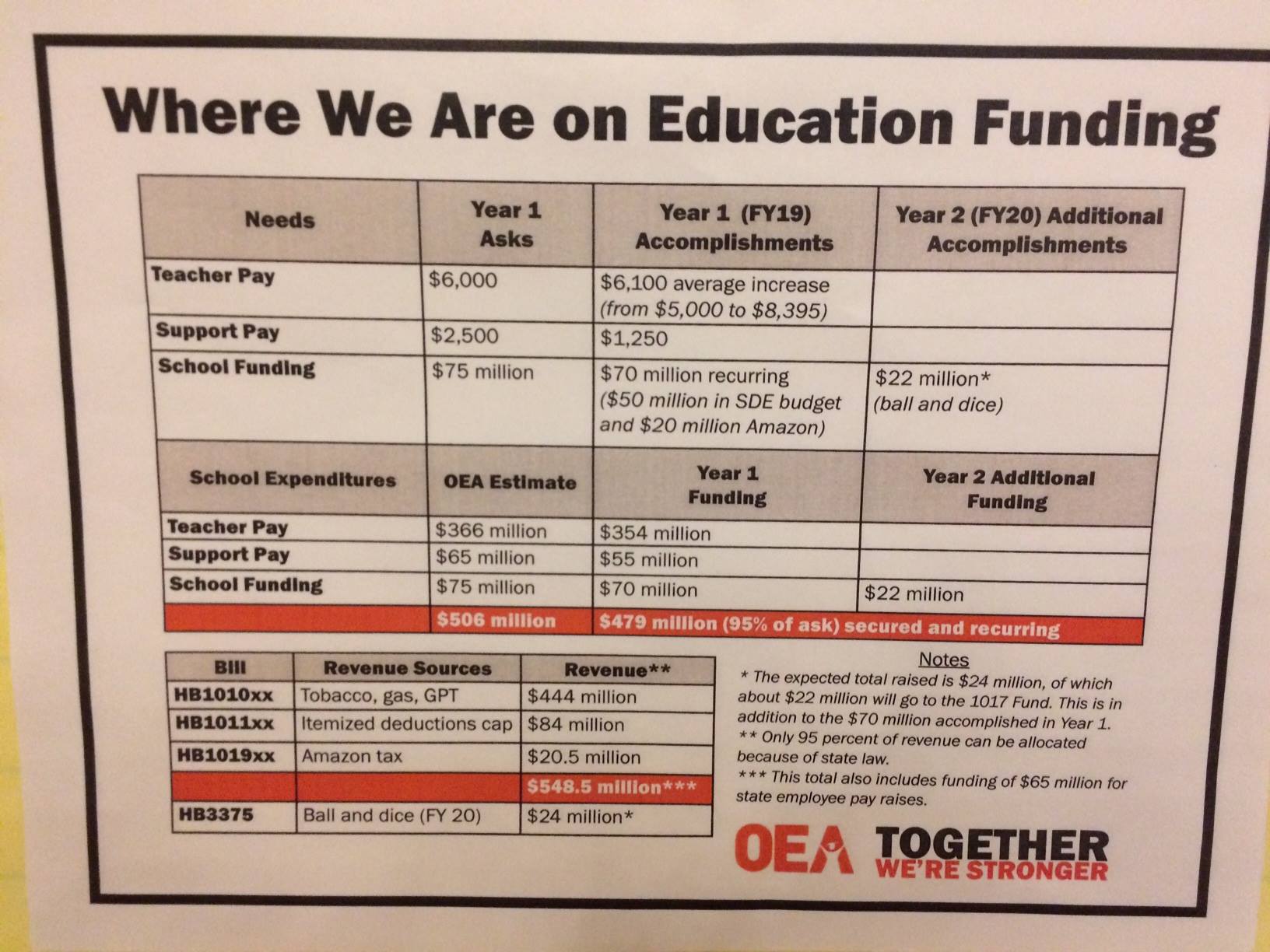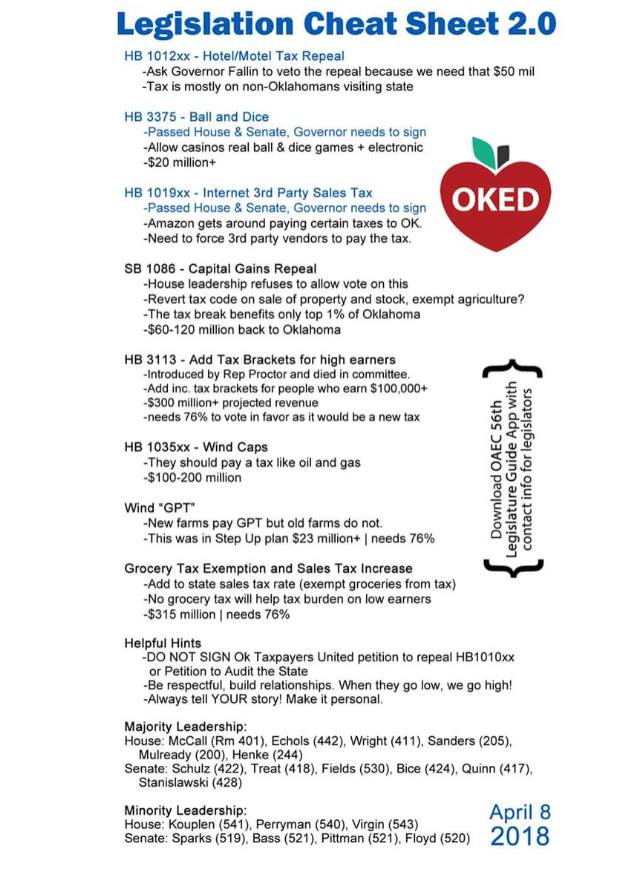Education: April 2018 Archives
Here is a textbook example of public choice theory, coming from a Norman school teacher, who was complaining that leaders of the Oklahoma Education Association, the state affiliate of the far-left National Educational Association, haven't been listening to teachers and aren't thinking strategically about accomplishing their tax-hike goals.
Norman High School teachers agree that the OEA's demands are not realistic, especially calling for a capital gains tax that could hurt agriculture.They would rather see a repeal of the income tax break.
'They are absolutely being unrealistic, because...agriculture has a great lobbying force,' said Dawn Brockman. 'With income tax, there's not going to be the calls to legislators, so why not go after income tax. It's a cost of an average of $30 per person.'
The concentrated cost to agriculture of a capital gains tax would motivate them to fight effectively, despite the strong motivation of the teachers to secure a concentrated benefit. Why not instead diffuse the cost over the general public? Joe Taxpayer won't feel enough pain to march on the State Capitol. He has no lobbyists; no one at the State Capitol represents his interests.
Legislators are also complaining about the OEA leadership. An OEA handout summarizing the state of play claims that only 95% of the "ask" is funded by tax increases, so more taxes are needed. (Click to enlarge.) OCPA Action's Dave Bond posted this flyer on Facebook, noting that lawmakers "have fully funded teacher pay raises, support staff pay raises, more textbook $, more funding formula $ and more (paid for by raising over $560 million in new revenue)":
The OEA flyer drew a strong reaction from State Sen. A. J. Gay-Griffin, a strong supporter of the tax increases:
This is such crap. I'm just so tired of the lies. STOP LISTENING TO THE OEA!
Chad Warmington, president of the Oklahoma Oil and Gas Association,
In response to a question, Sen. Gay-Griffin wrote:
I support the current investment funded by well thought out and vetted policy cussed and discussed for over a year. I don't support the current money grab OEA is pushing and the diminishing of the investment secured for education.
Having betrayed the taxpayers by voting for a tax increase, these legislators find that they haven't won new friends among the OEA. The legislators passed the pay raise and the tax increase before the strike began, and had the union been negotiating in good faith, there wouldn't have been a walkout at all. The OEA's game, it appears, was all along to have two weeks of disruption and protest at the Capitol leading up to the filing period now underway. No amount of concessions by the Republicans would have sent the teachers home, because the protest was the point. It's all about setting up the Democrats (and RINOs) to win in November, so that taxes can be raised more easily in the future.
If only the Republican governor and Republican supermajority in the Legislature had approved performance audits back in 2013 (or earlier), they might have been able to provide raises before now without raising taxes, and the OEA's leverage would have been minimal.
MORE: Here is another summary of taxes and allocations that shows $29 million more in new revenue than the "ask":
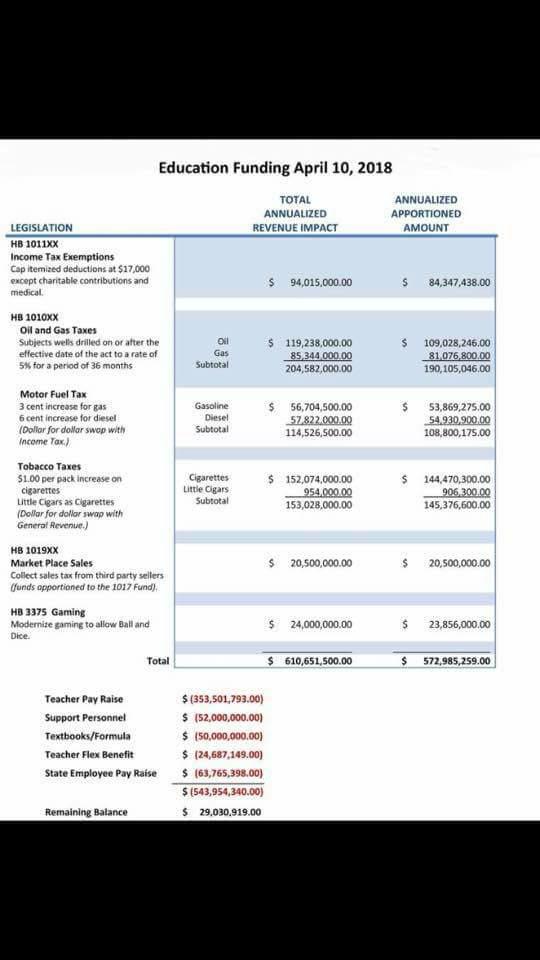
MORE commentary from Oklahoma and elsewhere:
Jon Gabriel at Ricochet writes about the teacher strikes across the country:
Like most non-government workers, I've gone years at a time without a raise. For the same reason, I have been laid-off due to a bad economy. A pension? As if. Yet I never picketed my various employers, stopped showing up to work, or demanded that my overtaxed neighbors pony up cash.I'm sure that teachers believe they're underpaid; pretty much everyone thinks they're underpaid. But they should remember that the vast majority of taxpayers also are struggling and have been for a long time. These strikes aren't harming politicians, but kids and their parents. And the last thing an angry parent wants to do is to give more money to people making their lives miserable.
Meanwhile, all the teachers are showing up at my kids' charter schools here in Arizona. I expect that a lot of new students will be joining them in the fall.
Dave Ruthenberg writes in the Enid News and Eagle about the well-funded OEA leaders and their far-left causes, and he has his suspicions about the reasons behind the strike:
There is little need to rehash the causes of the work stoppage other than to note teachers continue to march upset they were voted a 16 percent (on average) pay raise. The average worker would be quite thrilled with such a pay hike, but that's not enough to appease the OEA, which has steadfastly managed to move the goalposts (first it was all about pay then it was about textbooks, then it was about classroom overcrowding), making it impossible to reach any resolution.If it appears the OEA's objective all along is the Capitol chaos we are witnessing, it's because that's exactly what it's all about. The OEA has been itching for this fight, damn any reasonable discussions....
According to the most recently available filing of IRS form 990, an annual filing requirement for tax exempt organizations, in 2016 OEA President Alicia Priest was pulling down a cool $92,349 (or about three times the average teacher salary). Its executive director, David Duvall, was really living the life, raking in $152,091, above most school superintendents' pay.
Ruthenberg notes the OEA/NEA's outspoken support for illegal immigration and gun control, and their opposition to measures that would protect students from attackers.
OEA's agenda goes far beyond wages and takes a hard left turn into advocacy of policies that are anathema to common-sense Oklahomans, who, through their taxes -- which are going through a significant hike -- are helping to fund and being told it's not enough.However, each day the walkout continues, the OEA overplays its hand, and the growing sentiment becomes enough is enough, more so when OEA's full agenda is exposed.
I'll be on 1170 KFAQ with Pat Campbell Wednesday morning, April 11, 2018, just after the 8:00 am news to discuss the teachers' strike, the race for governor and other political topics. Listen at 1170 on the AM dial, online, or on the Tune In app.
A collection of notes about the Oklahoma teachers' strike, which has extended over seven school days so far.
The teachers' unions continue to move the goalposts and act like they've gotten nothing. This handout circulated at the capitol on Monday morning, purporting to be the latest set of demands, including repeal of the capital gains tax exemption that was approved in 2004, veto of the reversal of the proposed $5 nightly tax on hotel rooms, taxes on the wind industry, and an increase in the state sales tax rate (offset by a grocery exemption).
Alicia Priest, head of the Oklahoma affiliate of the far-left National Education Association, emphasized two demands as the strike ended its first week: Taxing long-term capital gains and reinstating the hotel/motel tax that was approved with the original tax package, then repealed by a separate bill. But it didn't seem to matter to her if any of the money went to schools.
Reporter: So, you are asking for 100 percent of the capital gains?Priest: I'm saying that we need the repeal of the hotel/motel repeal and we need to pass capital gains in order for the walkout to end.
Reporter: What portion of capital gains for education?
Priest: I'm not...
Reporter: So, the walkout would end if (the governor) vetoes the hotel/motel tax and capital gains passes, but not another dime goes to the student funding formula?
Priest: I don't think that is it at all. I think we have to get them passed and work on getting funding to public education.
This is a significant overreach. I understand the OEA lobbying for more more money to schools, but why specify the funding mechanism? Why should it matter to the OEA where the money is coming from? The answer, I believe, is that as a state affiliate of the left-wing NEA, they just want more money flowing to government. I have to wonder if this was part of a deal -- funding for strike expenses in exchange for pushing for a tax on capital gains.
It's also a non-starter. Oklahoma business owners and farmers understand how this tax would hurt them. Investors would find it much more attractive to invest their money south of the Red River as Texas has no income tax at all and thus no tax on capital gains. If we want businesses to be able to grow and create jobs and diversify our economy, they must have access to capital investment. In his FY 2005 budget, Gov. Brad Henry, a Democrat, called for a long-term capital gains exemption:
A key to economic growth, and especially wage and income growth, is investment. Accordingly, any practice, policy or law that discourages investment in Oklahoma is not in the state's best interest and should be changed. One such policy is the taxation of gains on investment in Oklahoma. This budget recommends a full exemption from the individual income tax for all capital gains resulting from Oklahoma business interests or property held for five years or more.
The folks at the state and metro chambers of commerce must feel rather used right now. They've been vocal in supporting higher taxes for education and have helped to build the platform of positive publicity that the teachers' unions are now using to call for a tax that would damage their members. The bill passed the Senate but won't be heard by the House. Had the unions succeeded in browbeating passage of the tax, they would have found their erstwhile allies leading and funding the repeal effort. Legislative leaders have said that the capital gains tax came out of the funding package in order to get the votes needed for passage.
The teachers would have been wise to have their one-day show of force at the capitol and then returned to the classroom. They don't have much to show -- ball-and-dice games in casinos and Amazon tax -- for seven days of lobbying.
Someone else who feels hung out to dry is State Rep. Kevin McDugle. His frustrated video complaint about teacher behavior at the capitol, posted the morning of the strike's second day, went viral. McDugle voted for the tax increases and voted to make it easier for the legislature to impose higher taxes, alienating many of the Republican constituents who supported him, supposing him to be a conservative. In his Facebook video, he didn't specify the behavior that got under his skin, but clearly he felt the teachers were not sufficiently appreciative of the political risks he and others took to give them their demands. His video drew brickbats from the union teachers -- and an opponent to his re-election. McDugle now finds himself not only politically homeless and in the midst of what looks like a messy divorce, in his wife, the plaintiff cites adultery as grounds for divorce, a charge McDugle denies.
That aside, it's not smart to alienate the people who have helped you. I'm sure McDugle isn't the only legislator who feels underappreciated right now, and many may wish they could get their vote back. I read somewhere that the reason the $5 hotel tax needed a separate repeal, rather than being taken out during conference committee, is that House leaders were uncertain that they'd be able to get 76 votes for the bill the second time through. By continuing to push, despite the big legislative win that happened before the walkout, teachers are risking the same sort of backlash that followed passage of HB 1017.
In a press release in connection with her signing the repeal of the new $5 hotel tax, Oklahoma Gov. Mary Fallin has said she's done with education funding for the year, and it's time to move on. I'm not a Fallin fan, but she's right about this.
Fallin said today's action should complete funding K-12 public schools for the 2019 fiscal year. She encouraged legislators to turn attention now on other issues, such as criminal justice, and address the financial needs of other core services, such as public safety and health and human services, in finishing work on the 2019 fiscal year budget.
Dave Bond of OCPA tallied all of the new funding for education approved in the last three weeks, most of it before the strike began (bullets added for legibility):
HB 1010xx - signed by Governor BEFORE the teacher's union walkout began:
- cigarette tax increase = $152 million
- little cigars tax increase = $1 million
- gasoline fuel tax increase = $51 million
- diesel fuel tax increase = $53 million
- oil gross production tax raised to 5% = $95 million
- natural gas gross production tax raised to 5% = $71 million
HB 1011xx - signed by Governor BEFORE the teacher's union walkout began:
- itemized deductions capped at $17k = $94 million
HB 3375 - awaits Governor's signature:
- gaming expansion ("ball & dice") to be assessed exclusivity fee = $24 million
HB 1019xx - awaits Governor's signature:
- third-party sales on Amazon now assessed sales tax = $19 million
Total new revenue = $560 million
That represents a 19% increase in state appropriations for public education and moves Oklahoma to 2nd in average regional teacher's pay and 1st in benefits.
Four of the six major Republican candidates for governor have gone on record about the recent tax increases. Lt. Gov. Todd Lamb, Gary Richardson, and Kevin Stitt all said they would have vetoed them, State Auditor Gary Jones would have signed them into law (and took credit for the plan), and outgoing Oklahoma City Mayor Mick Cornett wouldn't say one way or the other. Former State Rep. Dan Fisher was not quoted in the story.
Lamb said the package "gets an 'F' in reform. I'm opposed to tax increases. We continue to kick the reform can down the road ... I'm very frustrated and very disappointed in how this teacher pay raise was signed and how it was passed."
That certainly narrows the field for me. I'd already ruled out Mick Cornett, but now I'm ruling out Gary Jones as well. I appreciate Jones in his role as State Auditor, I respect his integrity, but I have also observed over the years that he has a hard time thinking outside the box. I want a governor that is aggressively looking for ways to deliver state services without growing government and increasing our tax burden. Where Jones sees barriers and hurdles to getting money where it needs to go, a real leader in the governor's office would push to tear those barriers down, even if it means amending the constitution or changing laws. Some people are pushing to change the constitution to make it easier to impose tax increases on the people without their approval; why not instead change the constitution to make it easier to allocate the tax dollars government already receives to the areas where they're most needed?
In hindsight, Jones deserves some of the blame for the current lack of leadership at the State Capitol. Jones was elected Oklahoma Republican Party chairman after the disastrous 2002 election, when Democrats used cockfighting and fears of school consolidation to mobilize rural voters for Brad Henry. Jones's platform focused on building the party in rural areas. He and his team recruited legislative candidates who were not party activists or vocal conservatives but rather were respected leaders in the community who happened to be registered Republican. The strategy was successful in winning seats that Republicans had never before held, ultimately producing Republican supermajorities, but many (perhaps most) of these new legislators did not have the grounding in principle to withstand the blandishments of lobbyists and bureaucrats. As a result, we don't have a principled conservative majority in either chamber, and, consequently, significant cost-saving reforms that might have provoked resistance from vested interests didn't move forward. Thus we found ourselves in a budgetary dilemma that, to Jones's way of thinking, could only be solved by a tax increase. That same lack of political courage meant that the legislature wouldn't override Governor Fallin's veto of a 2013 bill that would have created a joint legislative committee authorized to direct his State Auditor's office to conduct performance audits of state agencies.
Amongst the discussion about education funding in Oklahoma is the claim that the large proportion of teachers with emergency or alternative certification is a danger sign -- we can't staff our schools with teachers that have the proper credentials. Getting the proper credentials involves taking certain courses in educational philosophy and method and some amount of student teaching.
Thinking back to my teachers at Holland Hall in the 1970s, very few of them had degrees in education. They had at least a bachelor's degree, typically in the field they were teaching, but they also had enthusiasm and a gift for communicating with students. The same is true of the teachers that my children have had in their private school experience.
In light of that, I thought it would be interesting to look back at the early days of teacher training. Oklahoma has six regional colleges that began life as normal schools, institutions for training teachers: University of Central Oklahoma, Northwestern Oklahoma State University, Southwestern Oklahoma State University in old Oklahoma Territory, and Northeastern State University, East Central University, and Southeastern Oklahoma State University in old Indian Territory. Langston University served a dual role: Its name at birth was the Oklahoma Colored Agricultural and Normal University, serving as the "separate-but-equal" Morrill Act counterpart to Oklahoma A&M and as a teachers' school for the African-American population.
A large number of other state universities began life as normal schools, including Illinois State University (in Normal, Illinois), Indiana State University, UCLA, and several branches of the SUNY system. What made a normal school normal was that students would be taught a particular set of norms for common education. This would include not only theoretical instruction but classroom experience, often by means of teaching children attending a training school attached to the normal school.
The oldest of Oklahoma's erstwhile normal schools is UCO, which began life in 1891 as Territorial Normal School. After the territorial legislature established Southwestern and Northwestern, it was renamed Central State Normal School. The Central State Normal School prospectus for 1913-1914, a 32-page brochure aimed at prospective students, is available on the Internet Archive, and it's fascinating reading. It tells us a lot about attitudes and expectations for public education a century ago.
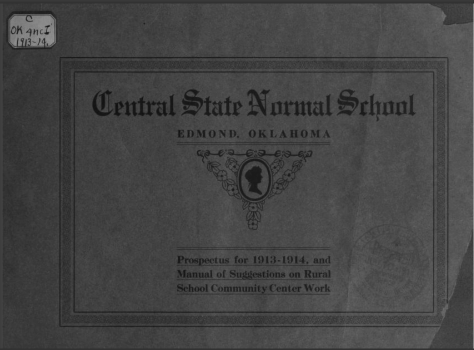
What Central State Normal offered prospective teachers were certificates which would free them from having to take certification tests -- "grinding examinations" -- on a regular basis in order to get a job teaching. If you already had at least three years of high school, you could study for three terms at Central and get a certificate good for two years "in any county of Oklahoma." If you had a high school diploma, six terms at CSN would earn you a State Life Diploma -- a permanent certification to teach. The terms could be non-consecutive -- studying summers while teaching. The summer session of 1913 attracted 1,286 students. Teachers in districts that begin in late fall -- perhaps delayed because of the cotton harvest -- could take the opportunity to attend CSN for the fall term as well. For those students who could not come to Edmond, CSN offered correspondence courses, but you could only take one per year, and you still needed a year on campus for a diploma.
Students with only an eighth-grade education could come to CSN for a four-year preparatory course (high school) followed by the two year sequence of college-level teaching courses. Students could major in science, foreign languages (German, French, or Latin), or elementary teaching; the differences between majors were seen mainly in the high school years.
WILL YOU HEED THE CALL?There is a call constantly going out--give us a trained teacher for primary grades, principals and superintendents.
Students completing three years of high school work and doing satisfactory work for one year will be entitled to the Two-Year State Certificate. Students completing the Four-Year Normal Preparatory Course or a course equivalent to a standard four-year course in high school will receive a Two-Year State Certificate. This entitles the holder to teach in any county of Oklahoma for two years immediately following issuance.
Students completing a four-year high school course may take thirty-six weeks' work here and receive the Elementary State Certificate and at the same time have advanced to within one year of the State Life Diploma. To secure a State Two-Year Certificate, to become independent of grinding examinations for two years, to possess a license to teach and acquire funds to enter school again, to have the profit and pleasure of a year in a great state institution of learning and to get within one year of the State Life Diploma good in this and twenty more states of America, is the largest privilege ever granted to a high school graduate. Would it not pay you to begin right now to get this training? The school year consists of three regular twelve week terms -- fall, winter, spring -- and one summer term equivalent in every way to a regular term....
We extend to all friends of education a cordial invitation to visit Central State Normal over the hourly trolley from Oklahoma City, or Santa Fe.
The college-level requirements included two terms of psychology, two terms of pedagogy, two terms of advanced composition, three terms of observation and teaching, two terms of history of education, a term of philosophy of education, three terms of either manual training or domestic science, two terms of a teachers course, and a term of something called "Ind. Geog." Students following the elementary teacher's preparatory course took some of those classes during their high school years, leaving room in the two college years for courses like genetic psychology, child study, sociology, and advanced pedagogy.
The prospectus put a great deal of emphasis on Central's progressive and modern outlook, with modern technologies like a motion picture machine, Kodaks, and a phonograph available, and put forward the teacher as an agent of progress in Oklahoma communities, using school facilities for much more than teaching grade-school children. That's worth further exploration in another entry, but the crusading tone reminds me very much of Carol Kennicott, the central character of Sinclair Lewis's Main Street.
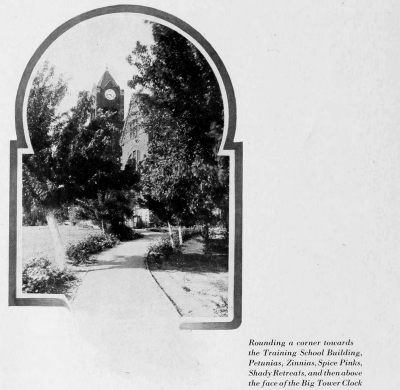
CNS boasted that it was easily accessible from anywhere, as there was an hourly trolley to Edmond from Oklahoma City from 6 a.m. to midnight, as well as service from Oklahoma City via steam train on the Santa Fe railroad.
TO THE OKLAHOMA CITY, EL RENO, AND YUKON HIGH SCHOOL GRADUATES RESIDING NEAR TROLLEY LINE.Over fifty Oklahoma City high school graduates came to Central State Normal this summer. There was a reason. Here it is: Central State Normal is on the hourly trolley line with Oklahoma City. This puts the oldest and largest State Normal School at the front gate of every pupil along the trolley line. To the high school graduate of Oklahoma City, and all towns along the trolley system, Central State Normal says: "Attend school here three terms taking proper credits and you will be awarded a Two Year State Certificate, recognized in any county, town, etc., of Oklahoma." It matters not whether these three terms be taken consecutively or not. Three summer terms will make a complete year. Add to these three terms another year's work in this school and you have a Life Diploma, freeing you from all examinations, and introducing you to the best position in education in this state and to all throughout the land. Besides this, you have done two years of college work and will be given equivalent credits in any College or University for such advancement.
So the Oklahoma City, the El Reno and other high school graduates in towns along the trolley line have a Two Year State Certificate within their grasp by three terms' work -- a Life Diploma, by six terms' work.
What wonder then that the high school graduates of these places are buying reduced rates over the trolley line to Central State Normal and thereby working out one of life's greatest opportunities?
Of the 30 faculty members, only 4 had master's degrees and an additional 10 had bachelor's degrees. No degree is listed for the remaining 16. It would be another five years before the school would be authorized to offer a four-year degree. At that point in time, a high school diploma was considered sufficient to teach students through eighth grade, but modern schools would have wanted teachers to have the additional training afforded by a normal school.
